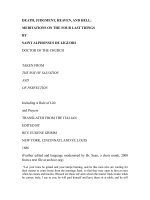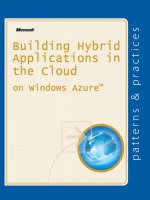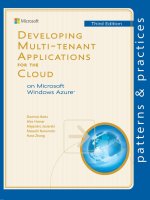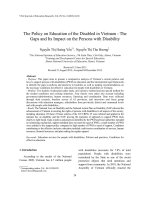developing and hosting applications on the cloud [electronic resource]
Bạn đang xem bản rút gọn của tài liệu. Xem và tải ngay bản đầy đủ của tài liệu tại đây (7.8 MB, 386 trang )
ptg8286219
ptg8286219
Developing and
Hosting
Applications
on the Cloud
ptg8286219
This page intentionally left blank
ptg8286219
IBM WebSphere
Deployment and Advanced
Configuration
Roland Barcia, Bill Hines, Tom Alcott, and Keys Botzum
Developing and
Hosting
Applications
on the Cloud
Alex Amies, Harm Sluiman, Qiang Guo Tong,
Guo Ning Liu
IBM Press
Pearson plc
Upper Saddle River, NJ • Boston • Indianapolis • San Francisco
New York • Toronto • Montreal • London • Munich • Paris • Madrid
Cape Town • Sydney • Tokyo • Singapore • Mexico City
Ibmpressbooks.com
ptg8286219
The authors and publisher have taken care in the preparation of this book, but make no expressed or
implied warranty of any kind and assume no responsibility for errors or omissions. No liability is assumed
for incidental or consequential damages in connection with or arising out of the use of the information or
programs contained herein.
© Copyright 2012 by International Business Machines Corporation. All rights reserved.
Note to U.S. Government Users: Documentation related to restricted right. Use, duplication, or disclosure
is subject to restrictions set forth in GSA ADP Schedule Contract with IBM Corporation.
IBM Press Program Managers: Steven M. Stansel, Ellice Uffer
Cover design: IBM Corporation
Editor-in-Chief: Dave Dusthimer
Marketing Manager: Stephane Nakib
Acquisitions Editor: Mary Beth Ray
Publicist: Heather Fox
Managing Editor: Kristy Hart
Designer: Alan Clements
Project Editor: Betsy Harris
Copy Editor: Krista Hansing Editorial Services, Inc.
Senior Indexer: Cheryl Lenser
Compositor: Nonie Ratcliff
Proofreader: Language Logistics, LLC
Manufacturing Buyer: Dan Uhrig
Published by Pearson plc
Publishing as IBM Press
IBM Press offers excellent discounts on this book when ordered in quantity for bulk purchases or special
sales, which may include electronic versions and/or custom covers and content particular to your business,
training goals, marketing focus, and branding interests. For more information, please contact
U. S. Corporate and Government Sales
1-800-382-3419
For sales outside the United States, please contact
International Sales
ptg8286219
The following terms are trademarks or registered trademarks of International Business Machines
Corporation in the United States, other countries, or both: IBM, the IBM Press logo, IBM SmartCloud,
Rational, Global Technology Services, Tivoli, WebSphere, DB2, AIX, System z, Rational Team Concert,
Jazz, Build Forge, AppScan, Optim, IBM Systems Director, and developerWorks. A current list of IBM
trademarks is available on the web at “copyright and trademark information” at
www.ibm.com/legal/copytrade.shtml.
Windows and Microsoft are trademarks of Microsoft Corporation in the United States, other countries, or
both. Java and all Java-based trademarks and logos are trademarks or registered trademarks of Oracle
and/or its affiliates. Linux is a registered trademark of Linus Torvalds in the United States, other countries,
or both. UNIX is a registered trademark of The Open Group in the United States and other countries. Intel,
Intel logo, Intel Inside, Intel Inside logo, Intel Centrino, Intel Centrino logo, Celeron, Intel Xeon, Intel
SpeedStep, Itanium, and Pentium are trademarks or registered trademarks of Intel Corporation or its
subsidiaries in the United States and other countries.
Other company, product, or service names may be trademarks or service marks of others.
All rights reserved. This publication is protected by copyright, and permission must be obtained from the
publisher prior to any prohibited reproduction, storage in a retrieval system, or transmission in any form or
by any means, electronic, mechanical, photocopying, recording, or likewise. To obtain permission to use
material from this work, please submit a written request to Pearson Education, Inc., Permissions
Department, One Lake Street, Upper Saddle River, New Jersey 07458, or you may fax your request to
(201) 236-3290.
ISBN-13: 978-0-13-306684-5
ISBN-10: 0-13-306684-3
ptg8286219
This book is dedicated to all the members of the IBM
®
SmartCloud
™
Enterprise development team whose hard work and professionalism
has made this large and challenging project a reality.
ptg8286219
vii
Contents
Preface xiii
Introduction 1
Part I: Background Information
Chapter 1 Infrastructure as a Service Cloud Concepts 7
Workloads 8
Use Cases 10
Actors 10
Web Site Hosting 10
Short-Term Peak Workloads 11
Proof-of-Concept 12
Extra Capacity 14
Open Source/Enterprise Collaboration 15
Storage System for Security Videos 15
Business Scenario: IoT Data Hosting Provider 16
Virtualization 17
Infrastructure as a Service Clouds 22
Other Cloud Layers 24
Virtual Machine Instances 26
Virtual Machine Images 26
Storage 27
Block Storage 27
File-Based Storage 28
Network Virtualization 29
IP Addresses 30
Network Virtualization 30
Desktop Virtualization 32
ptg8286219
Part II: Developing Cloud Applications
Chapter 2 Developing on the Cloud 35
Linux, Apache, MySQL, and PHP 35
Windows 40
Java 2 Enterprise Edition 40
Java SDK 41
WebSphere Application Server 41
Relational Database 47
Data Persistence 49
Messaging 54
Scheduled Events 58
Business Scenario: Developing the IoT Data Portal 59
Integration of Application Lifecycle Management Tools with Clouds 67
Rational Application Developer 69
Rational Team Concert 72
Build and Deployment Automation 75
Business Scenario: Application Lifecycle Management Tools 84
Chapter 3 Developing with IBM SmartCloud Enterprise APIs 85
Resource Model 86
Entity Lifecycles 87
Command Line 91
Environment Setup 91
Querying the Catalog 92
Provisioning an Instance 92
Provisioning Storage 96
Provisioning an Instance with Parameters 97
Managing IP Addresses 98
Saving Images 99
Java API 100
Environment Setup 100
Querying the Catalog 101
Working with Virtual Machine Instances 104
Locations and Capabilities 108
Working with Images 110
Uploading Files When Creating a New Instance 111
Minimizing REST Calls 112
Example: Developing a Maven Cloud Plug-In 114
REST API 122
Background 122
Using PHP to Invoke the IBM SmartCloud Enterprise REST APIs 125
Example: create instance Form 130
viii Contents
ptg8286219
Example: Page to Show a List of Instances 139
Using Java to Invoke the IBM SmartCloud Enterprise REST APIs 144
Rational Asset Manager 146
Business Scenario: Using Elastic Cloud Services to Scale 152
Chapter 4 Standards 157
Data Exchange 157
Extensible Markup Language (XML) 157
JavaScript Object Notation (JSON) 160
REST 162
Background 163
HyperText Transfer Protocol 163
REST Architecture 164
Implementing and Consuming REST Services 165
Example: Uploading Files When Creating Instances with REST 169
JAX-RS 171
Virtualization 178
Open Virtualization Format 179
Cloud Computing 179
Cloud Computing Reference Architecture 180
Distributed Management Task Force Open Cloud Standards Incubator 180
Cloud Data Management Interface 181
Business Scenario: IoT Data Use of Standards 181
Chapter 5 Open Source Projects 183
Virtualization Projects 183
Kernel-Based Virtual Machine (KVM) 183
QEMU 185
libvirt 186
Xen 188
Cloud Projects 188
Eucalyptus 188
Apache Libcloud 189
Delta Cloud 190
OpenStack 190
Cloud Foundry 191
Hadoop 191
Setting up Hadoop 192
Business Scenario: Data Management 194
Chapter 6 Cloud Services and Applications 197
Creating and Customizing Images 197
Operating Systems Specifics 200
Modeling Deployment Topologies 200
Contents ix
ptg8286219
Services 206
Linux Services 207
Windows Services 209
Networking 209
Basic Network Settings 209
Software Installation and Management 211
Red Hat Package Management and YUM 211
Software Management on SUSE 211
Cloud Software Bundles 212
Open Service Gateway Initiative (OSGi) 213
Storage 223
Block Storage 224
File-Based Storage 226
File Systems 227
Network Storage Systems 230
Structured Storage 231
Managing Storage on IBM SmartCloud Enterprise 232
Remote Desktop Management 233
X Windows 233
Virtual Network Computing (VNC) 234
NX Remote Desktop 236
Composite Applications 237
Email 238
Setting up an SMTP Server 238
Software as a Service 239
Document-Management Systems 239
Email and Collaboration Suites 241
Business Scenario: The IoT Data Application 242
Part III: Exploring Hosting Cloud Applications
Chapter 7 Security 243
Background 243
Business Scenario: IoT Data Security Context 244
Public Key Infrastructures and Certificates 245
Example: Trusted Certificate Signing Authorities in WebSphere Application Server 249
Identity and Access Management 252
Configuring Authentication and Access in J2EE Applications 254
Managing Users with Lightweight Directory Access Protocol 256
Enabling an Application for Multitenant Access 260
Federated Identity Management 260
OAuth 261
x Contents
ptg8286219
Network Security 266
Firewalls 266
Example: Connecting to a VLAN through a Firewall 271
Operating System Network Security Mechanisms 271
Business Scenario: Network Deployment and Firewall Rules 272
Proxy Servers 273
Virtual Private Networks 276
Browser Security 278
Application Hardening 280
Cross-Site Scripting 280
Cross-Site Request Forgery 281
SQL and Other Injection Attacks 282
Secure Communication Protocols 282
Secure Shell (SSH) 283
HTTPS 290
Internet Protocol Security (IPSec) 293
Operating System and Virtual Machine Security 293
Basic Operating System Tools 293
Security-Enhanced Linux 294
Security of Data at Rest 298
Security Events 298
Security Compliance 299
Business Scenario: IoT Data Security Architecture 300
Chapter 8 Performance, Availability, Monitoring,
and Metering 301
Performance and Scalability 301
Compute Capacity 302
Network Performance 302
J2EE Application Performance and Scalability 304
Performance Analysis and Testing 307
Availability 310
Backup, Recovery, and Restore 311
Storage Availability 314
Availability of Relational Databases 315
Virtual IP Addresses 316
Monitoring and Metering 317
Operating System Monitoring 318
Network Monitoring 323
Application Monitoring 323
Comprehensive Monitoring Solutions 327
Business Scenario: IoT Data Performance, Availability, Monitoring, and Metering Plan 328
Contents xi
ptg8286219
Chapter 9 Operations and Maintenance on the Cloud 331
Business Support Systems 331
Maintaining Compatibility with Future Versions of Software 333
An Evolving API 334
Java 334
REST 335
XML 336
JSON 336
Command Line 337
Data 337
Business Scenario: IoT Data Operations and Maintenance Plan 337
Further Reading 339
References 345
Index 355
xii Contents
ptg8286219
xiii
Preface
We are writing this book to share our experience over the past several years of developing the
IBM SmartCloud
™
Enterprise. We hope that readers will not just learn more about that cloud, but
also be inspired to build solutions using it or other clouds as a platform. We hope that people
using other clouds will benefit from this book as well.
ptg8286219
This page intentionally left blank
ptg8286219
xv
Acknowledgments
Thanks to many dedicated colleagues at IBM who have worked on IBM SmartCloud Enterprise
and other related products and projects. In particular, thanks to all the customers and people
inside IBM who are using the IBM SmartCloud Enterprise, for their feedback and questions,
especially the Rational
®
team. We gained a great deal of insight about the use of the cloud from
these questions and discussions, and it forced us to look at the cloud from an outside-in point of
view.
Thanks also to the entire IBM SmartCloud development team for its hard work and dedica-
tion in building this wonderful platform, working through unreasonable schedules and difficult
technical problems in the process.
Thanks to these specific people who helped with suggestions and review:
• Chris Roach, Program Manager, Cloud Technology, IBM
• Doug Davis, Senior Technical Staff Member, Web Services and Cloud Standards, IBM
• Dikran Meliksetian, Senior Technical Staff Member, Integrated Technology Delivery,
IBM
• Jamshid Vayghan, PhD, IBM Distinguished Engineer and Director, CTO Sales Trans-
formation, IBM
• Michael Behrendt, Cloud Computing Architect, IBM
• Prasad Saripalli, PhD, Principal Architect, IBM Cloud Engineering
• Scott Peddle, Advisory Software Engineer, IBM Global Technology Services
®
• Shane Weeden, Senior Software Engineer and IBM Tivoli
®
Federated Identity Manager
development lead, who helped us understand OAuth and FIM.
• Stefan Pappe, IBM Fellow, Cloud Services Specialty Area, IBM
ptg8286219
This was a personal effort by the authors and is not representative of IBM or its views. IBM
did not participate in and does not endorse this work. However, the authors thank IBM for access
to the IBM SmartCloud Enterprise system and the opportunity to work on such a challenging and
satisfying project.
xvi Acknowledgments
ptg8286219
xvii
About the Authors
Alex Amies is a Senior Software Engineer with IBM and an architect on the IBM Smart-
Cloud Enterprise development team.
Harm Sluiman is a Distinguished Engineer with IBM and the technical lead for Smart-
Cloud Enterprise.
Qiang Guo Tong is an Advisory Software Engineer with IBM and one of the lead develop-
ers for SmartCloud Enterprise.
Guo Ning Liu is a Staff Software Engineer with IBM and worked on development of the
public APIs, provisioning services, and security for SmartCloud Enterprise.
ptg8286219
This page intentionally left blank
ptg8286219
1
Introduction
The goal of this book is to help enterprises develop and operate services on the cloud. In particu-
lar, we hope that independent software vendors will be inspired to build value-add services on
public clouds. Additionally, we hope that developers of applications who make heavy use of
Infrastructure as a Service (IaaS), such as developers of Platform as a Service, Software as a
Service, and Business as a Service, will find this book useful. The target audience is developers
who use cloud-management application programming, architects who are planning projects, and
others who want to automate the management of IT infrastructure. The book is intermediate in
level but still offers a broad overview of the entire topic of IaaS clouds and aims to give a basic
background on most of the prerequisites needed to understand the topics discussed.
The book makes special reference to the IBM SmartCloud Enterprise. However, the
principles are general and are useful to anyone planning to automate the management of IT infra-
structure using cloud technology. In contrast to technical product documentation, the book tells a
story about why you might want to use the technologies described and includes sufficient back-
ground material to enable you to build the cloud applications described without having to consult
numerous external references. The references are listed as suggestions for further reading, not as
prerequisites to understanding the information presented.
Today cloud computing is bringing application development, business, and system opera-
tions closer together. This means that software developers need to better understand business
process and system operations. It also means that business stakeholders and operations staff have
to consume more software. The promise of cloud computing is that centralization, standardiza-
tion, and automation will simplify the user experience and reduce costs. However, fully achieving
these benefits requires a new mindset. The scope of this book is intentionally broad, to cover
these aspects of application development and operation. In addition, the book is quite practical,
ptg8286219
providing numerous code examples and demonstrating system utilities for deployment, security,
and maintenance.
The plan of the book runs from simple to more challenging. We hope that it gives applica-
tion developers an idea of the different possible applications that can be developed. As a result,
we look at some adjacent areas and related standards. Many of the topics discussed are not new;
however, they are strategic to cloud computing and, when necessary, we review them so that read-
ers do not need to seek background information elsewhere. We also will demonstrate several rel-
atively older technologies, such as Linux services and storage systems, that are finding new uses
in cloud computing.
Above all, this book emphasizes problem solving through cloud computing. At times you
might face a simple problem and need to know only a simple trick. Other times you might be on
the wrong track and need some background information to get oriented. Still other times, you
might face a bigger problem and need direction and a plan. You will find all of these in this book.
We provide a short description of the overall structure of a cloud here, to give the reader an
intuitive feel for what a cloud is. Most readers will have some experience with virtualization.
Using virtualization tools, you can create a virtual machine with the operating system install soft-
ware, make your own customizations to the virtual machine, use it to do some work, save a snap-
shot to a CD, and then shut down the virtual machine. An Infrastructure as a Service (IaaS) cloud
takes this to another level and offers additional convenience and capability.
Using an IaaS cloud you can create the virtual machine without owning any of the virtual-
ization software yourself. Instead, you can access the tools for creating and managing the virtual
machine via a web portal. You do not even need the install image of the operating system; you
can use a virtual machine image that someone else created previously. (Of course, that someone
else probably has a lot of experience in creating virtual machine images, and the image most
likely went through a quality process before it was added to the image catalog.) You might not
even have to install any software on the virtual machine or make customizations yourself; some-
one else might have already created something you can leverage. You also do not need to own any
of the compute resources to run the virtual machine yourself: Everything is inside a cloud data
center. You can access the virtual machine using secure shell or a remote graphical user interface
tool, such as Virtual Network Computing (VNC) or Windows
®
Remote Desktop. When you are
finished, you do not need to save the virtual machine to a CD; you can save it to the cloud storage
system. Although you do not have to own any of the infrastructure to do all this yourself, you still
have to pay for it in some way. The cloud provider handles that automatically as well, based on
the quantity of resources that you have used. This is the cloud pay-as-you-go concept.
The cloud provider has to invest in a lot of infrastructure to support this. Figure I.1 shows a
high-level overview of an Infrastructure as a Service cloud.
2 Introduction
ptg8286219
Figure I.1 Conceptual diagram of an Infrastructure as a Service cloud
The figure shows two cloud data centers with rack-based servers. Each server has many
CPUs and can support multiple virtual machines of different sizes. This is a major investment for
the cloud provider and the first advantage that a cloud user might think of, compared to in-house
virtualization: With a cloud, you can have as many computing resources as you need for as short
or long of a duration as desired; you are not limited by the computing capacity of your local facil-
ities. We refer to this characteristic as elasticity. You also connect to the cloud via the Internet,
which is convenient if you are hosting a web site but requires you to consider security. This is
where the virtual local area network shown in Figure I.1 can help you.
The cloud also provides a network storage system, which you can use for storing either vir-
tual machine images or data. Although the cost of ownership of network storage systems is
declining, owning your own network storage system is still expensive and affordable to usually
only medium to large companies. Blocks of the storage system can be carved off and made avail-
able as block storage volumes that can attach to virtual machines. Another aspect of data storage
and backup in cloud environments is that multiple data centers are available for making redun-
dant copies of data and providing high availability for mission-critical applications.
The cloud portal provides all this self-service as an additional aspect of cloud computing,
which is a great savings for enterprises. No need to ask an administrator every time you need a
new server, IP address, or additional storage—the cloud portal provides a control panel that gives
Introduction 3
User
Internet
(SSH)
Manage
Virtual Machines
Storage
System
Virtual
Machine
Data Center 1
Virtual Local Area
Network
Cloud Portal
Data Center 2
Racks
Save Data
Save Image
ptg8286219
you an overview of resources that end users can manage on demand. Not only are fewer adminis-
trators needed, but the consumers of the resources also have access to the resources more quickly.
This results in both a savings in capital and staff needed and a more agile business.
Another aspect of cloud computing that is immediately apparent to independent software
vendors is that public clouds provide a platform for a marketplace. Visibility of resources and ser-
vices on the cloud can be categorized at three levels: private, shared, and public. Publicly visible
resources, especially virtual machine images, provide an opportunity for independent software
vendors to sell services.
Ter m in o l og y
This section gives some of the basic terminology for cloud computing, to give readers a common
resource for the terms used. Upcoming chapters explain the terminology in more detail for spe-
cialized aspects of cloud computing.
instance—A virtual machine instance. Sometimes referred to as a node.
image—A template for creating a virtual machine. A large file that saves the state of a
virtual machine so that a new virtual machine can be created from it.
virtual local area network (VLAN)—An abstraction of the traditional local area net-
work that does not depend on physical connections. A VLAN usually is a resource that a
cloud user uses and is isolated from the Internet.
public cloud—A cloud from which multiple enterprises or individuals can consume
services. IBM SmartCloud Enterprise is a public cloud that allows only enterprises as
customers.
private cloud—A cloud that an enterprise operates for its sole use.
multitenant—A service that multiple tenants share. In this context, a tenant is usually
an enterprise, and separation of the tenants’ resources is implied.
compute size—The number of virtual CPUs, amount of memory, and hard disks dedi-
cated to a virtual machine.
elasticity—The capability to scale resources on demand, such as dynamically adding
virtual machines or IP addresses.
Organization of the Book
The book is divided in to three parts.
Background Information
The first part of the book covers background knowledge on cloud computing. It begins with
Chapter 1, “Infrastructure as a Service Cloud Concepts,” and covers the basic reasons for using
4 Introduction
ptg8286219
cloud computing by looking at some use cases. This chapter then explains some basic cloud con-
cepts and the resource model of the entities we are managing. The chapter provides a context and
language for the chapters that follow. It is followed by a description of how to set up development
environments in the cloud. To this point, all the concepts apply equally to any Infrastructure as a
Service cloud.
Developing Cloud Applications
The second part of the book describes how to use cloud tools and develop simple cloud applica-
tions, and it explores potential cloud application areas. It includes chapters on developing on the
cloud, developing with the IBM SmartCloud Enterprise, leveraging standards, and creating cloud
services and applications. The chapters also describe the command-line toolkit, Java, and REST
APIs for managing resources specifically for IBM SmartCloud Enterprise, as well as provide a
number of code examples. In addition, this part discusses standards that relate to cloud comput-
ing and some open source projects and covers how to leverage those standards to interoperate
between clouds. Following that, this part describes several application areas that are becoming
important in cloud computing, such as image customization, network services, software installa-
tion and management, storage, and remote desktops.
Exploring Hosting Cloud Applications
The third section of the book discusses hosting applications on the cloud. This includes chapters
on security; monitoring, performance, and availability; and operations and maintenance on the
cloud. First, we provide an overview of relevant security areas and techniques for hardening
applications. We then discuss monitoring, performance, and availability. Finally, we discuss busi-
ness support systems and maintenance.
The book uses a scenario to illustrate and tie together the different concepts discussed.
Throughout, we focus on a hypothetical company called IoT Data that provides a data storage
service for Internet-enabled devices.
Disclaimer
Any recommended solutions contained in this book are not guaranteed. Warranty is not implied
for any source code. All source code should be understood as sample for illustrative purposes
only. IBM does not support or endorse any information in this book.
Disclaimer 5
ptg8286219
This page intentionally left blank





![development with the force.com platform [electronic resource] building business applications in the cloud](https://media.store123doc.com/images/document/14/y/zs/medium_Qs04cLaWf8.jpg)
![developing and hosting applications on the cloud [electronic resource]](https://media.store123doc.com/images/document/14/y/sx/medium_sxb1401382082.jpg)
![epub straight to the point [electronic resource] [creating ebooks for the apple ipad and other ereaders]](https://media.store123doc.com/images/document/14/ne/xs/medium_xsa1401589411.jpg)

